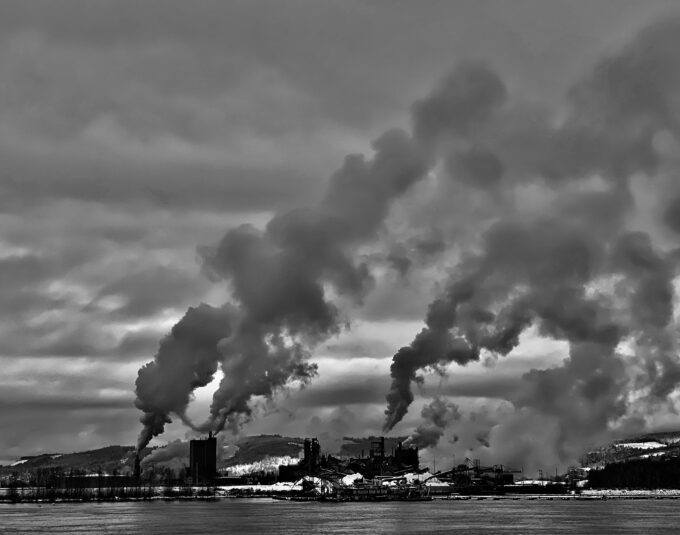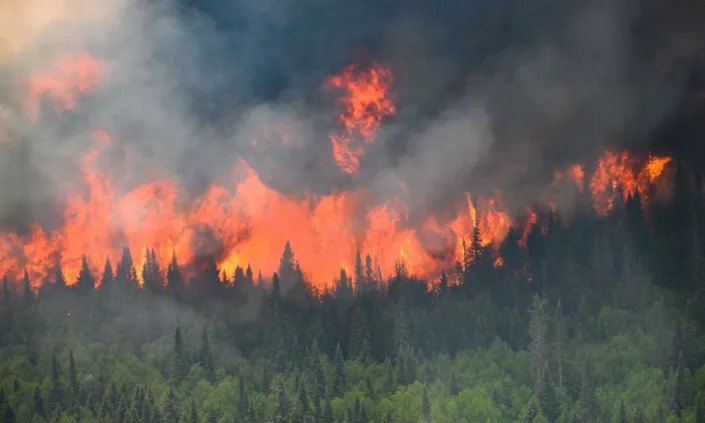Keir Starmer pledges to end North Sea exploration and let areas profit from clean power
James Cook - Scotland editor
Mon, June 19, 2023

oil platform near Invergordon
Labour will end new North Sea oil and gas exploration, but help communities profit from clean power projects, Sir Keir Starmer has pledged.
Speaking in Edinburgh, the Labour leader vowed to "cut bills, create jobs and provide energy security".
He also said that a previously announced publicly-owned green energy company will be based in Scotland.
Sir Keir is under pressure from environmentalists and the oil industry over the scale and pace of change.
Climate campaigners have criticised the party for rowing back on a pledge to invest £28bn a year in green industries.
In England, planning rules which effectively ban new onshore wind farm developments will be scrapped if Labour wins the next election.

Sir Keir Starmer says he wants to make Britain a clean energy superpower
Labour has confirmed it would "not grant licences to explore new fields" in the North Sea, a momentous shift for a sector which supports 200,000 UK jobs, including 90,000 in Scotland, according to trade body Offshore Energies UK.
But the party insists it will honour any licences in existence at the time of the next election, which must be held by January 2025. That is likely to include the controversial new Rosebank development west of Shetland.
Sir Keir said: "Labour will deliver lower bills, good jobs, and energy security for Scotland and the whole UK, as Britain leads the world in the fight against climate change."
One of Labour's initiatives will be to provide more incentives for areas to take part in new clean energy projects. Under Labour's plans, GB Energy - the new publicly-owned firm which it says will be based in Scotland at a location yet to be decided - would play a key role in getting that message across.
What does net zero mean and how is the UK doing?
Where does the UK get its energy and electricity?
It would oversee the return of profits from successful projects to local councils. The councils could then use that income to reduce council tax, pay for improved public services or simply provide rebates on energy bills.
Labour says GB Energy could end up providing up to £600m per year to local councils to invest in green infrastructure and a further £400m annually in low interest loans for community projects.
These community loans would be designed to ensure small projects could benefit from the expertise of GB Energy while also generating money for local areas.

Aberdeen harbour
But Offshore Energy UK's chief executive David Whitehouse told the BBC that Labour's plans to move away from the reliance of North Sea oil and gas "would create a cliff edge". deterring investment and heightening the risk of energy shortages.
Mr Whitehouse said 180 of the North Sea's 283 active oil and gas fields were due to close by 2030, and new licences were "essential" or production would "plummet" and "the UK and its skilled workforce will be exposed".
When Scottish Labour leader Anas Sarwar discussed the proposals on the BBC's Sunday with Laura Kuenssberg, Sharon Graham, general secretary of the trade union Unite, responded on Twitter by calling his remarks "simply not acceptable," accusing UK Labour of a "total lack of detail", and adding "these throw away comments cost jobs".
But Philip Evans, of Greenpeace UK, said the idea that the plans would "lead to an overnight shutdown of the industry" was nonsense.
Labour's opposition to new exploration licences represented "genuine leadership" he added, and the party was right "to debunk scare stories being peddled by climate delayers".
'No backsliding'
Mike Childs, head of science, policy and research at Friends of the Earth, welcomed Labour's latest ideas but warned "there can be no backsliding on pledges to stop new oil and gas extraction and invest in green growth".
Environmental groups are particularly vocal about their opposition to the proposed Rosebank development in the North Atlantic.
Industry and government sources say the field could be approved by the UK government's North Sea Transition Authority within weeks.
Norwegian state-controlled oil company Equinor said Rosebank could produce almost 70,000 barrels of oil a day at its peak.
Sir Keir has held private talks with senior energy industry figures in the past week and previously gave direct assurances to Equinor that a Labour government would not revoke any licences.
Instead the party says its focus is on delivering "cheaper zero carbon power by 2030" and its "mission" includes plans to attract and incentivise investment "in the UK's industrial heartlands".

The ban against on-shore wind farms will be lifted if Labour wins the election
That is likely to provoke comparisons with the approach taken by the US Democratic president Joe Biden whose Inflation Reduction Act has been described by the UK Conservative government's Business Secretary Kemi Badenoch as "protectionist".
Sir Keir has accused the Conservatives and the SNP of having abysmal records on renewables. "Labour will deliver lower bills, good jobs, and energy security for Scotland and the whole UK, as Britain leads the world in the fight against climate change," he said.
"The route to making Britain a clean energy superpower, slashing energy bills and creating tens of thousands of quality jobs, runs through Scotland," Sir Keir added.
The Scottish Conservatives' energy spokesman Liam Kerr described Labour's plans as "ruinous" for the UK's oil and gas industry, claiming they "would throw up to 90,000 highly skilled workers in the North East under a bus pretty much overnight".
A Scottish government spokesperson said it was committed to "a planned and fair transition" away from fossil fuels that did not imperil jobs, adding: "Simply stopping all future activity overnight is wrong.
"It could threaten energy security while destroying the very skills we need to transition to the new low-carbon economy."
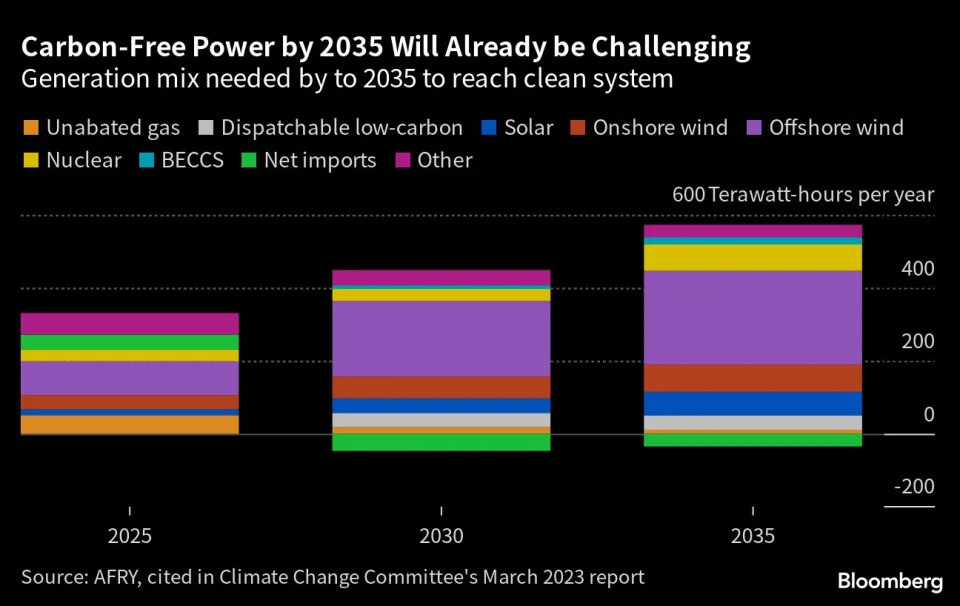
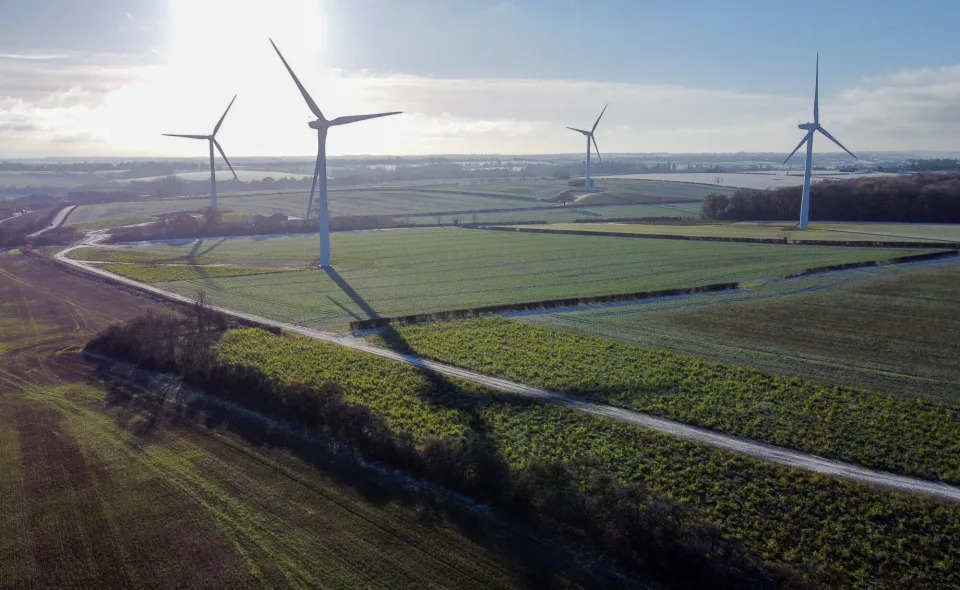
Andrew Atkinson and Joe Mayes
Mon, June 19, 2023
(Bloomberg) -- The UK’s main opposition Labour Party vowed to cut energy bills, create jobs and provide more secure electricity if it wins the next general election, as its leader Keir Starmer tries to attract support ahead of a vote expected next year.
Labour plans to make Britain a “clean energy superpower” by 2030, Starmer told ITV on Monday ahead of a speech he’s due to deliver in Scotland. He said Britain needs to boost its energy independence and spur renewables.
Opposition proposals include lifting a ban on new onshore wind farms within months of taking office and cutting the time taken to complete clean power projects from years to months with “tough new targets.”
The goals reiterate promises that both Labour and Conservative governments alike have made and failed to keep since the turn of the century. Business leaders complain that planning rules and bureaucracy are holding back investment, especially in critical green technologies like wind farms, electric-car battery plants and carbon capture facilities.
Starmer said his party would reform planning rules to stop so-called nimbyism blocking projects. He told BBC radio that he wanted local people to benefit from new projects through cheaper bills and investments by developers in local improvements.
“We have to have a mechanism where we can move forward,” Starmer told the BBC. There can’t be “individual vetoes all across the country,” he said.
Scaling Back
Starmer is seeking to boost confidence in Labour’s commitment to green energy after the party scaled back its plan to invest £140 billion ($180 billion) over five years on a clean energy transition because of cost concerns. It now plans to “ramp up” to £28 billion a year, rather than deliver that figure from the beginning of the next parliamentary term.
The original plan fell victim to Shadow Chancellor Rachel Reeves’ efforts to show a more fiscally conservative face to voters ahead of an election polls show they can win next year. Industry leaders says the clean-power goals are all but impossible.
“We’ve got to roll up our sleeves and start building things, run towards the barriers — the planning system, the skills shortages, the investor confidence, the grid,” Starmer said in excerpts released by Labour ahead of his speech.
“If the status quo isn’t good enough, we must find the reforms that can restart our engine. I’m not going to accept a situation where our planning system means it takes 13 years to build an offshore wind farm.”
Britain would run on 100% clean power by 2030 under Labour, Starmer is due to say, cutting £1,400 off household bills and £53 billion off energy bills for businesses. Industry experts say the clean power goal is impossible.
“2030, even with the best will in the world, I would say is impossible,” Phil Thompson, chief executive of clean energy developer Balance Power Group Ltd. said earlier this month. “We have to be super ambitious because the planet isn’t getting any cooler and it’s a case of shoot for the stars, but I think technically it’s not achievable unless someone has got a magic wand.”
Polling Lead
Labour also needs to make sure its backers in the unions are on board with its plans and there have already been signs of disquiet. Unions want to make sure fossil fuel jobs aren’t destroyed before enough new ones are created.
Read more: Labour’s Starmer Defends UK Energy Plan After Union Critique
Under Labour’s plans, a new public body, GB Energy, would be created to build jobs and supply chains, together with a National Wealth Fund to invest alongside the private sector in gigafactories, clean steel plants, renewable-ready ports, green hydrogen and energy storage.
Labour, which has a double-digit lead in opinion polls over Prime Minister Rishi Sunak’s Conservatives, is hoping a strong climate policy will help it win votes at the next election. A vote, due by January 2025, is widely expected to be held next year.
Starmer will deliver his pledge alongside Scottish Labour leader Anas Sarwar, Reeves and Shadow Energy Secretary Ed Miliband. They will seek to show a united front despite internal tensions over the move to row back the scale of investment.
Bloomberg Businessweek
Nick Gutteridge
Sun, June 18, 2023
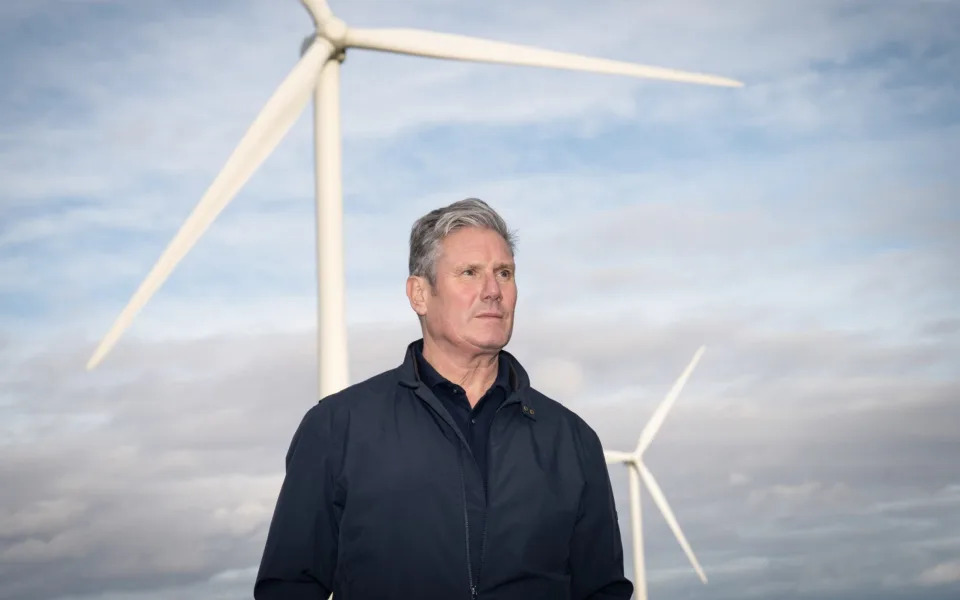
Sir Keir Starmer will say in a speech in Scotland: 'We’ve got to roll up our sleeves and start building things,' including new wind turbines - Stefan Rousseau/PA
Sir Keir Starmer will scrap the ban on new onshore wind farms as one of his first acts in Downing Street if Labour wins the next election.
The opposition leader will vow to “throw everything” at his net zero agenda by firing the starting gun on a “race” to build more turbines across the country.
He will unveil plans to tear up planning laws and halve the length of time it takes for projects to be approved from two years to less than 12 months.
During a speech in Scotland on Monday, he will tell voters they would save hundreds of pounds on their bills under his vision to make Britain a “clean energy superpower”.
Labour says it plans to lift the de facto ban on new wind farms in England, introduced by the Tories in 2012, within its “first months” in power.
But he will make the address following more accusations of “flip-flopping” after he watered down plans to end new North Sea oil and gas projects.
‘Race of our lifetime’
“We can cut bills, create jobs and provide energy security for Britain – that’s what a Labour government will deliver,” Sir Keir will tell an audience in Scotland.
“We’ve got to roll up our sleeves and start building things, run towards the barriers – the planning system, the skills shortages, the investor confidence, the grid.
“If the status quo isn’t good enough – we must find the reforms that can restart our engine.
“I’m not going to accept a situation where our planning system means it takes 13 years to build an offshore wind farm.”
He will add: “We’re going to throw everything at this: planning reform, procurement, long-term finance, R&D, a strategic plan for skills and supply chains.
“We’ve got to seize the new opportunities. This is the race of our lifetime and the prize is real.”
Labour’s energy plan, set to be published on Monday, will formally commit to reversing the onshore wind ban within its first year in power.
But a source close to Sir Keir said he plans to go much faster and bring legislation to the House of Commons within months, adding: “We are going to push on with it ASAP.”
Sir Keir has vowed to reduce the planning process for putting up new turbines “from years to months” and to double output from onshore wind by 2030.
The decade-long ban has added £182 per year to the typical family’s bills by making Britain more reliant on expensive imported energy, he will claim.
Labour has pledged to create a net zero electricity grid by 2030.
Sir Keir’s speech will come after he was criticised by the Tories and some within his own party for watering down two of his key green energy pledges.
He has softened his vow to end all new North Sea oil and gas projects after it came under fire from the unions for putting thousands of jobs at risk.
The announcement comes after Rachel Reeves, the shadow chancellor, admitted the party’s flagship Green Prosperity Plan is being delayed.
Labour had pledged to spend £28 billion a year on climate-friendly policies but has now said it will not reach that target until it has been in power for at least two and a half years.
Esther McVey, a former Conservative cabinet minister, said on Twitter:
Sir Keir will also attack the SNP for failing to deliver on its clean energy pledges, saying his plan will ensure there is “British power for British jobs” and bolster the union.
He will announce that GB Energy, a new state-owned energy company which Labour plans to set up, would have its headquarters in Scotland.
Under the proposals, residents of communities that host green energy production such as wind farms will be rewarded with money off their bills.
Councils will also be required to proactively identify areas of land that can be turned over for the generation of renewable electricity.
Anas Sarwar, the Scottish Labour leader, has confirmed the party will now allow any new oil and gas licences that are approved by the Tories before it takes power to go ahead.
“We cannot shut off oil and gas, and oil and gas will be a significant part of our energy industry for decades to come,” he told Times Radio.
Grant Shapps, the Energy Security and Net Zero Secretary, told The Telegraph: “Time and again Labour have proven they just can’t be trusted with our economy and our energy security.
“By surrendering to Just Stop Oil’s guerrilla tactics, Keir Starmer is admitting that Labour will decimate the economy, put hundreds of thousands of jobs at risk and undermine everything we have done to get bills falling.”
A Conservative Party spokesman added that the proposals would “weaken the UK’s energy security, making us more dependent on Putin”.
Offshore Energies UK, the industry body, has warned Labour’s plan would create 45,000 job losses and lead to a 60 per cent drop in domestic oil and gas production.
The package of reforms being outlined by Sir Keir is seen as vital to making Britain’s electricity grid carbon-free by 2030.
Industry insiders view this goal as extremely challenging, with one boss of a major power generator saying it would be “virtually impossible”.
However, constraints on the planning system and the grid connection queuing process are seen as key bottlenecks.
Under the “first come, first serve” system, developers of solar farms and battery storage projects have been told they may have to wait until the 2030s for their projects to be hooked up to the grid – even though they only take a few years to build.
This has encouraged firms to “pay and spray” applications in different areas to increase their chances of success, clogging up the queue with speculative projects that are going nowhere.
A Labour source said the party would “rip up the queue system” for grid connections, replacing it with a “use it or lose it” process that forces developers to show progress or forfeit their application.
Meanwhile, the current planning process can force companies to carry out a plethora of environmental studies for renewable energy projects, even though other developers have already done similar work for other projects nearby – wasting time and money.
But Labour will pledge to require councils to set aside land for such schemes and investigate ways to allow offshore wind companies to be able to take advantage of existing environmental data to speed up project approvals.
Paul Cargill, PA Scotland
Sun, June 18, 2023
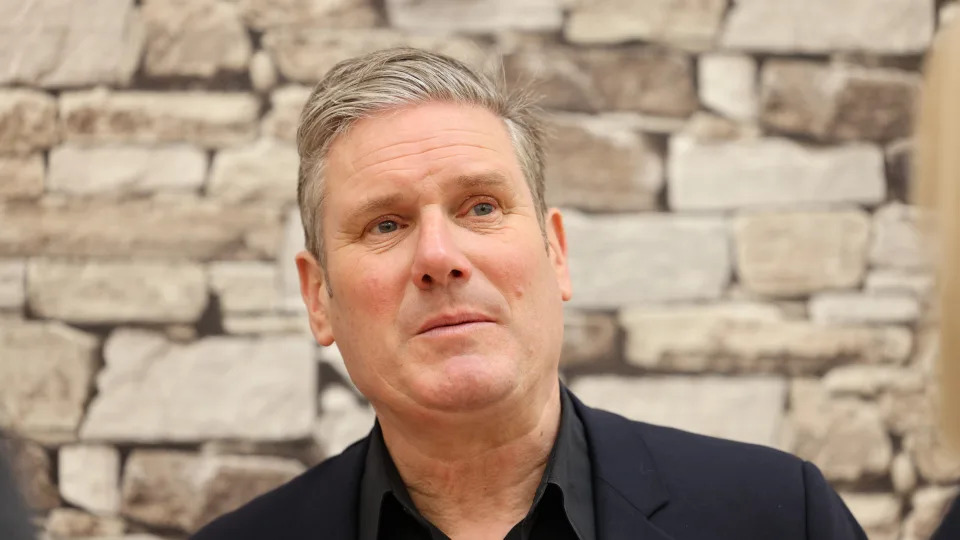
Thousands of jobs could be created in Scotland under a Labour proposal to create a publicly owned clean energy company and establish its headquarters north of the border, Sir Keir Starmer will say.
The Labour leader set out his proposal to launch Great British Energy (GBN) during his party conference speech in Liverpool last year as part of a strategy to turn the UK into a clean energy superpower.
He told attendees the company would be launched in the first year of a Labour government should the party win the next general election and has now revealed its headquarters would be based in Scotland.
Sir Keir is scheduled to expand on his party’s vision to deliver cheaper zero-carbon energy by 2030 during a joint statement alongside Scottish Labour leader Anas Sarwar on Monday.
The two leaders are expected to outline how Labour’s Green Prosperity Plan will deliver three key benefits for Scotland: building on Scotland’s energy and industrial history; doubling the number of jobs in low carbon sectors; and creating a clean power system by 2030 saving Scottish households £8.4 billion in that time.
Sir Keir will say: “The route to making Britain a clean energy superpower, slashing energy bills and creating tens of thousands of quality jobs runs through Scotland.
“That is why GB Energy, our publicly owned energy company, will be headquartered in Scotland, the heart of the British energy industry.
“I mean it when I say that our energy plans will be made in Scotland – cutting energy bills for Scottish families and delivering the jobs and investment in Scottish communities that for far too long have been let down by the SNP and Conservatives.
“When it comes to capitalising on Scotland’s energy resources, for 15 years the SNP Government has chased the headlines but not done the work.
“Labour will deliver lower bills, good jobs, and energy security for Scotland and the whole UK, as Britain leads the world in the fight against climate change.”
Mr Sarwar said: “I am determined to leave our children and future generations a better planet than we have now.
“But to do this, we need to sweep out both of our bad governments and deliver urgent action, because we are running out of time.
“What we are announcing today is the boldest energy plan Scotland and the whole UK has seen in generations – delivering a clean energy revolution by 2030.
“It will deliver 50,000 clean power jobs for Scotland and lower bills for working people.
“I’m delighted to announce it will also mean a publicly owned Great British Energy company – headquartered here in Scotland.
“GB Energy – backed by the strength of the UK Treasury – will make strategic investments to maximise our opportunities and bring jobs and prosperity to Scotland.
“A Labour government will unleash Scotland’s massive energy potential by making those strategic investments – that’s the change Scotland needs.”
SNP Energy Security and Net Zero spokesperson Alan Brown MP said: “Whether it’s the Tories or the pro-Brexit Labour Party, Westminster politicians have used Scotland as an energy cash cow for decades, so the pretence that they suddenly want to deliver a strategy for Scotland now is laughable.
“In Scotland, the damage of Westminster control is already done. Keir Starmer’s piecemeal proposal is too little, too late – and shows exactly why Scotland needs the full powers of independence.
“It has been decades of Westminster governments failing to properly harness Scotland’s immense energy resources that has left people across Scotland paying the price. Promising a GB Energy HQ doesn’t make up for decades of squandered oil and gas revenues.
“The SNP is serious about the transformative potential of green energy to Scotland’s success as part of a Just Transition – and the ambitious ScotWind project and the Scottish Government’s £500 million Just Transition Fund attest to that. But we want to go further.
“Labour is pro-Brexit, while Scotland is not. That means a UK Labour government will continue to ignore the needs, interests and wishes of people across Scotland and actively pursue policy that harms our interests.
“It could not be clearer that Scotland needs the full powers of independence to properly deliver clean, green and affordable renewable energy for the benefit of people living and working here.”


